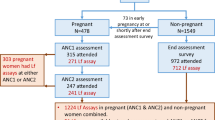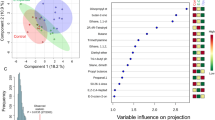Abstract
Objective: To confirm the results of an earlier study showing premenopausal equol excretors to have hormone profiles associated with reduced breast cancer risk, and to investigate whether equol excretion status and plasma hormone concentrations can be influenced by consumption of probiotics.
Design: A randomized, single-blinded, placebo-controlled, parallel-arm trial.
Subjects: In all, 34 of the initially enrolled 37 subjects completed all requirements.
Intervention: All subjects were followed for two full menstrual cycles and the first seven days of a third cycle. During menstrual cycle 1, plasma concentrations of estradiol (E2), estrone (E1), estrone-sulfate (E1-S), testosterone (T), androstenedione (A), dehydroepiandrosterone-sulfate (DHEA-S), and sex-hormone-binding globulin (SHBG) were measured on cycle day 2, 3, or 4, and urinary equol measured on day 7 after a 4-day soy challenge. Subjects then received either probiotic capsules (containing Lactobacillus acidophilus and Bifidobacterium longum) or placebo capsules through day 7 of menstrual cycle 3, at which time both the plasma hormone concentrations and the post-soy challenge urinary equol measurements were repeated.
Results: During menstrual cycle 1, equol excretors and non-excretors were not significantly different with respect to subject characteristics, diet, or hormone concentrations. Significant inverse correlations were found between E2 and body mass index (BMI) (P=0.02), SHBG and BMI (P=0.01), DHEA-S and dietary fiber (P=0.04), and A and protein:carbohydrate ratio (P=0.02). Probiotic consumption failed to significantly alter equol excretor status or hormone concentrations during menstrual cycle 3, although there were trends towards decreased concentrations of T (P=0.14) and SHBG (P=0.10) in the probiotic group.
Conclusions: We were unable to verify a previously reported finding of premenopausal equol excretors having plasma hormone concentrations different from those of nonexcretors. Furthermore, a 2-month intervention with probiotic capsules did not significantly alter equol excretion or plasma hormone concentrations.
This is a preview of subscription content, access via your institution
Access options
Subscribe to this journal
Receive 12 print issues and online access
$259.00 per year
only $21.58 per issue
Buy this article
- Purchase on Springer Link
- Instant access to full article PDF
Prices may be subject to local taxes which are calculated during checkout
Similar content being viewed by others
References
Adlercreutz H, Hamalainen E, Gorbach SL, Goldin BR, Woods MN & Dwyer JT (1989): Diet and plasma androgens in postmenopausal vegetarian and omnivorous women and postmenopausal women with breast cancer. Am. J. Clin. Nutr. 49, 433–442.
Adlercreutz H, Honjo H, Higashi A, Fotsis T, Hamalainen E, Hasegawa T & Okada H (1991): Urinary excretion of lignans and isoflavonoid phytoestrogens in Japanese men and women consuming a traditional Japanese diet. Am. J. Clin. Nutr. 54, 1093–1100.
Anderson KE, Rosner W, Khan MS, New MI, Pang SY, Wissel PS & Kappas A (1987): Diet–hormone interactions: protein/carbohydrate ratio alters reciprocally the plasma levels of testosterone and cortisol and their respective binding globulins in man. Life Sci. 40, 1761–1768.
Benno Y & Mitsuoka T (1992): Impact of Bifidobacterium longum on human fecal microflora. Microbiol. Immunol. 36, 683–694.
Bezkorovainy A (2001): Probiotics: determinants of survival and growth in the gut. Am. J. Clin. Nutr. 73, 399S–405S.
Bhathena SJ, Berlin E, Judd J, Nair PP, Kennedy BW, Jones J, Smith PM, Jones Y, Taylor PR & Campbell WS (1989): Hormones regulating lipid and carbohydrate metabolism in premenopausal women: modulation by dietary lipids. Am. J. Clin. Nutr. 49, 752–757.
Block G, Hartmann AM, Dresser CM, Carroll MD, Gannon J & Gardner L (1986): A data-based approach to diet questionnaire design and testing. Am. J. Epidemiol 124, 453–469.
Brouwers E, L'Homme R, Al-Maharik N, Lapcik O, Hampl R, Wahala K, Mikola H & Adlercreutz H (2003): Time-resolved fluoroimmunoassay for equol in plasma and urine. J. Steroid Biochem. Mol. Biol. 84, 577–588.
Cassidy A, Bingham S & Setchell KD (1994): Biological effects of a diet of soy protein rich in isoflavones on the menstrual cycle of premenopausal women. Am. J. Clin. Nutr. 60, 333–340.
Dai Q, Franke AA, Jin F, Shu XO, Hebert JR, Custer LJ, Cheng J, Gao YT & Zheng W (2002): Urinary excretion of phytoestrogens and risk of breast cancer among Chinese women in Shanghai. Cancer Epidemiol. Biomarkers Prev. 11, 815–821.
Dorgan JF, Reichman ME, Judd JT, Brown C, Longcope C, Schatzkin A, Forman M, Campbell WS, Franz C, Kahle L & Taylor PR (1996): Relation of energy, fat, and fiber intakes to plasma concentrations of estrogens and androgens in premenopausal women. Am. J. Clin. Nutr. 64, 25–31.
Duncan AM, Merz-Demlow BE, Xu X, Phipps WR & Kurzer MS (2000): Premenopausal equol excretors show plasma hormone profiles associated with lowered risk of breast cancer. Cancer Epidemiol. Biomarkers Prev. 9, 581–586.
Franks S, Kiddy DS, Hamilton-Fairley D, Bush A, Sharp PS & Reed MJ (1991): The role of nutrition and insulin in the regulation of sex hormone binding globulin. J. Steroid Biochem. Mol. Biol. 39, 835–838.
Gibson GR & Roberfroid MB (1995): Dietary modulation of the human colonic microbiota: introducing the concept of prebiotics. J. Nutr. 125, 1401–1412.
Goldin BR & Gorbach SL (1984): The effect of milk and lactobacillus feeding on human intestinal bacterial enzyme activity. Am. J. Clin. Nutr. 39, 756–761.
Goldin BR & Gorbach SL (1994): Hormone studies and the diet and breast cancer connection. Adv. Exp. Med. Biol. 364, 35–46.
Grenman S, Ronnemaa T, Irjala K, Kaihola HL & Gronroos M (1986): Sex steroid, gonadotropin, cortisol, and prolactin levels in healthy, massively obese women: correlation with abdominal fat cell size and effect of weight reduction. J. Clin. Endocrinol. Metab. 63, 1257–1261.
Hämäläinen EK, Adlercreutz H, Puska P & Pietinen P (1983): Decrease of serum total and free testosterone during a low-fat high-fibre diet. J. Steroid Biochem. 18, 369–370.
Hawksworth G, Drasar BS & Hill MJ (1971): Intestinal bacteria and the hydrolysis of glycosidic bonds. J. Med. Microbiol. 4, 451–459.
Hutchins AM, Slavin JL & Lampe JW (1995): Urinary isoflavonoid phytoestrogen and lignan excretion after consumption of fermented and unfermented soy products. J. Am. Diet. Assoc. 95, 545–551.
Ingram D, Sanders K, Kolybaba M & Lopez D (1997): Case–control study of phyto-oestrogens and breast cancer. Lancet 350, 990–994.
Kelly GE, Joannou GE, Reeder AY, Nelson C & Waring MA (1995): The variable metabolic response to dietary isoflavones in humans. Proc. Soc. Exp. Biol. Med. 208, 40–43.
Key TJ, Allen NE, Verkasalo PK & Banks E (2001): Energy balance and cancer: the role of sex hormones. Proc. Nutr. Soc. 60, 81–89.
Kirschner MA, Samojlik E & Silber D (1983): A comparison of androgen production and clearance in hirsute and obese women. J. Steroid Biochem. 19, 607–614.
Lampe JW, Gustafson DR, Hutchins AM, Martini MC, Li S, Wahala K, Grandits GA, Potter JD & Slavin JL (1999): Urinary isoflavonoid and lignan excretion on a Western diet: relation to soy, vegetable, and fruit intake. Cancer Epidemiol. Biomarkers Prev. 8, 699–707.
Lampe JW, Karr SC, Hutchins AM & Slavin JL (1998): Urinary equol excretion with a soy challenge: influence of habitual diet. Proc. Soc. Exp. Biol. Med. 217, 335–339.
Lampe JW, Skor HE, Li S, Wahala K, Howald WN & Chen C (2001): Wheat bran and soy protein feeding do not alter urinary excretion of the isoflavan equol in premenopausal women. J. Nutr. 131, 740–744.
Lee HP, Gourley L, Duffy SW, Esteve J, Lee J & Day NE (1991): Dietary effects on breast-cancer risk in Singapore. Lancet 337, 1197–1200.
Lu LJ, Lin SN, Grady JJ, Nagamani M & Anderson KE (1996): Altered kinetics and extent of urinary daidzein and genistein excretion in women during chronic soya exposure. Nutr. Cancer 26, 289–302.
Marteau P, Pochart P, Flourie B, Pellier P, Santos L, Desjeux JF & Rambaud JC (1990): Effect of chronic ingestion of a fermented dairy product containing Lactobacillus acidophilus and Bifidobacterium bifidum on metabolic activities of the colonic flora in humans. Am. J. Clin. Nutr. 52, 685–688.
Maskarinec G, Williams AE, Inouye JS, Stanczyk FZ & Franke AA (2002): A randomized isoflavone intervention among premenopausal women. Cancer Epidemiol. Biomarkers Prev. 11, 195–201.
Morton MS, Arisaka O, Miyake N, Morgan LD & Evans BA (2002): Phytoestrogen concentrations in serum from Japanese men and women over forty years of age. J. Nutr. 132, 3168–3171.
Plymate SR, Matej LA, Jones RE & Friedl KE (1988): Inhibition of sex hormone-binding globulin production in the human hepatoma (Hep G2) cell line by insulin and prolactin. J. Clin. Endocrinol. Metab. 67, 460–464.
Rao AV (1995): Effect of dietary fiber on intestinal microflora and health. In Dietary Fiber in Health & Disease eds D Kritchevsky and C Bonfield, pp 257–266. St. Paul: Eagan Press.
Richelle M, Merten-Pridmore S, Bodenstab S, Enslen M & Offord EA (2002): Hydrolysis of isoflavone glycosides to aglycones by beta-glycosidase does not alter plasma and urine isoflavone pharmokinetics in postmenopausal women. J. Nutr. 132, 2487–2592.
Rowland I, Wiseman H, Sanders T, Adlercreutz H & Bowey E (1999): Metabolism of oestrogens and phytoestrogens: role of the gut microflora. Biochem. Soc. Trans. 27, 304–308.
Rowland IR, Wiseman H, Sanders TA, Adlercreutz H & Bowey EA (2000): Interindividual variation in metabolism of soy isoflavones and lignans: influence of habitual diet on equol production by the gut microflora. Nutr. Cancer 36, 27–32.
Tsangalis D, Ashton JF, McGill AEJ & Shah NP (2003): Biotransformation of isoflavones by bifidobacteria in fermented soymilk supplemented with D-glucose and L-cysteine. J. Food Sci. 68, 623–631.
Volek JS, Kraemer WJ, Bush JA, Incledon T & Boetes M (1997): Testosterone and cortisol in relationship to dietary nutrients and resistance exercise. J. Appl. Physiol. 82, 49–54.
Wu AH, Ziegler RG, Horn-Ross PL, Nomura AM, West DW, Kolonel LN, Rosenthal JF, Hoover RN & Pike MC (1996): Tofu and risk of breast cancer in Asian-Americans. Cancer Epidemiol. Biomarkers Prev. 5, 901–906.
Zheng W, Dai Q, Custer LJ, Shu XO, Wen WQ, Jin F & Franke AA (1999): Urinary excretion of isoflavonoids and the risk of breast cancer. Cancer Epidemiol. Biomarkers Prev. 8, 35–40.
Acknowledgements
This research was supported by the General Clinical Research Center Grant MO1-RR00400 from the National Center for Research Resources and the Minnesota Agricultural Experiment Station. We would like to thank the study participants for their time and dedication, as well as the staff at the General Clinical Research Center, University of Minnesota. We are grateful to Jennifer Nettleton, Kris Greany, and Jill Hamilton-Reeves for their help with laboratory assays and Will Thomas for his help with statistical analysis. The soy protein isolate and probiotic capsules were generously donated by The Solae Company, St. Louis, MO, and UAS Laboratories, Minnetonka, MN, respectively.
Author information
Authors and Affiliations
Contributions
Contributors: MJLB was the primary author and study coordinator and assisted with subject recruiting; KAG was a study co-coordinator and assisted with subject recruiting; KEW helped with study design; WRP assisted with study design and provided medical consulting; JF assisted with study design and provided microbiological consulting; HA developed and performed the equol analysis; MSK was the principal investigator, who supervised all aspects of the study. All authors contributed to the data interpretation and manuscript preparation.
Corresponding author
Rights and permissions
About this article
Cite this article
Bonorden, M., Greany, K., Wangen, K. et al. Consumption of Lactobacillus acidophilus and Bifidobacterium longum do not alter urinary equol excretion and plasma reproductive hormones in premenopausal women. Eur J Clin Nutr 58, 1635–1642 (2004). https://doi.org/10.1038/sj.ejcn.1602020
Published:
Issue Date:
DOI: https://doi.org/10.1038/sj.ejcn.1602020
Keywords
This article is cited by
-
Development of a high-performance thin-layer chromatography method for the rapid quantification of S-equol in biological samples of albino Wistar rats
JPC – Journal of Planar Chromatography – Modern TLC (2024)
-
Probiotics and Prebiotics: Any Role in Menopause-Related Diseases?
Current Nutrition Reports (2023)
-
Soy isoflavones and their relationship with microflora: beneficial effects on human health in equol producers
Phytochemistry Reviews (2013)
-
Does equol production determine soy endocrine effects?
European Journal of Nutrition (2012)
-
Daidzein-metabolizing phenotypes in relation to mammographic breast density among premenopausal women in the United States
Breast Cancer Research and Treatment (2009)



